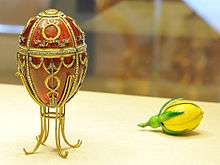Rosebud (Fabergé egg)
The Rosebud egg is a jewelled enameled Easter egg made by Michael Perchin under the supervision of the Russian jeweller Peter Carl Fabergé in 1895,[1] for Nicholas II of Russia, who presented the egg to his wife, Empress Alexandra Feodorovna.[1] It was the first egg that Nicholas presented to Alexandra.
| Rosebud Fabergé egg | |
|---|---|
 | |
| Year delivered | 1895 |
| Customer | Nicholas II |
| Recipient | Alexandra Feodorovna |
| Current owner | |
| Individual or institution | Viktor Vekselberg Fabergé Museum in Saint Petersburg, Russia |
| Year of acquisition | 2004 |
| Design and materials | |
| Workmaster | Michael Perchin |
| Surprise | A golden crown, with diamonds and rubies, and cabochon ruby pendant (lost) |
Surprise
.jpeg)
The egg opens like a bonbonnière to reveal a yellow-enamelled rosebud, in which the two surprises were originally contained. The surprises are missing, but they were a golden crown, with diamonds and rubies, and cabochon ruby pendant.[2] The crown was a reference to Alexandra Feodorovna's new role as Empress of Russia, following the accession to the throne of her husband, Nicholas II of Russia.[3]
History
After the death of Alexander III of Russia, his son, Nicholas married Princess Alix of Hesse and by Rhine, who subsequently became Empress Alexandra of Russia, following the accession to the throne of her husband, Nicholas II of Russia.[3] Princess Alix missed the rose garden of Rosenhöhe, Darmstadt, and so this egg reminded her of them during her first Easter with her new husband.[1] The familiar yellow rose in 1895 was the yellow China tea rose that had been introduced by Parkes from China in 1824, re-bloomed in fall and was a staple of milder gardens than Saint Petersburg, where it was not hardy.[4] Yellow roses were the most valued ones in the Empress' native Germany.
The egg embodied Fabergé's embrace of Neo-Classicism, in opposition to the dominance of Art Nouveau in late 19th century contemporary design.[1] Fabergé charged 3,250 rubles for the egg.[1]
In 1917 the egg was confiscated by the Russian Provisional Government and later sold to Emanuel Snowman of the jewellers Wartski around 1927.[2] It was owned by a certain Charles Parsons in the 1930s, and was lost for decades, amid rumours that it had been damaged in a marital dispute. It was this damage that helped Malcolm Forbes identify the egg when he purchased it in 1985 from the Fine Art Society in London. In 2004 it was sold as part of the Forbes Collection to Viktor Vekselberg. Vekselberg purchased some nine Imperial eggs from the collection, for almost $100 million.[5]
The egg is now part of the Victor Vekselberg Collection, owned by The Link of Times Foundation, and housed in the Fabergé Museum in Saint Petersburg, Russia.
See also
References
- "The Rosebud Egg, Chapter 4". Faberge: Treasures of Imperial Russia. The Link of Times Foundation. 2005. Retrieved 2007-12-05.
- Wintraecken, Annemiek (2016-05-30). "1895 Rosebud Egg". Mieks Fabergé Eggs. Retrieved 2016-05-30.
- "The Bay Tree Egg, Chapter 9". Faberge: Treasures of Imperial Russia. The Link of Times Foundation. 2005. Retrieved 2007-12-05.
- Henry Curtis, Beauties of the Rose (1850-1853).
- Economides, Michael (2006-03-23). "Energy Security from Russia". Energy Tribune. Retrieved 2007-12-05.